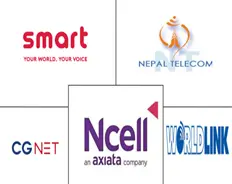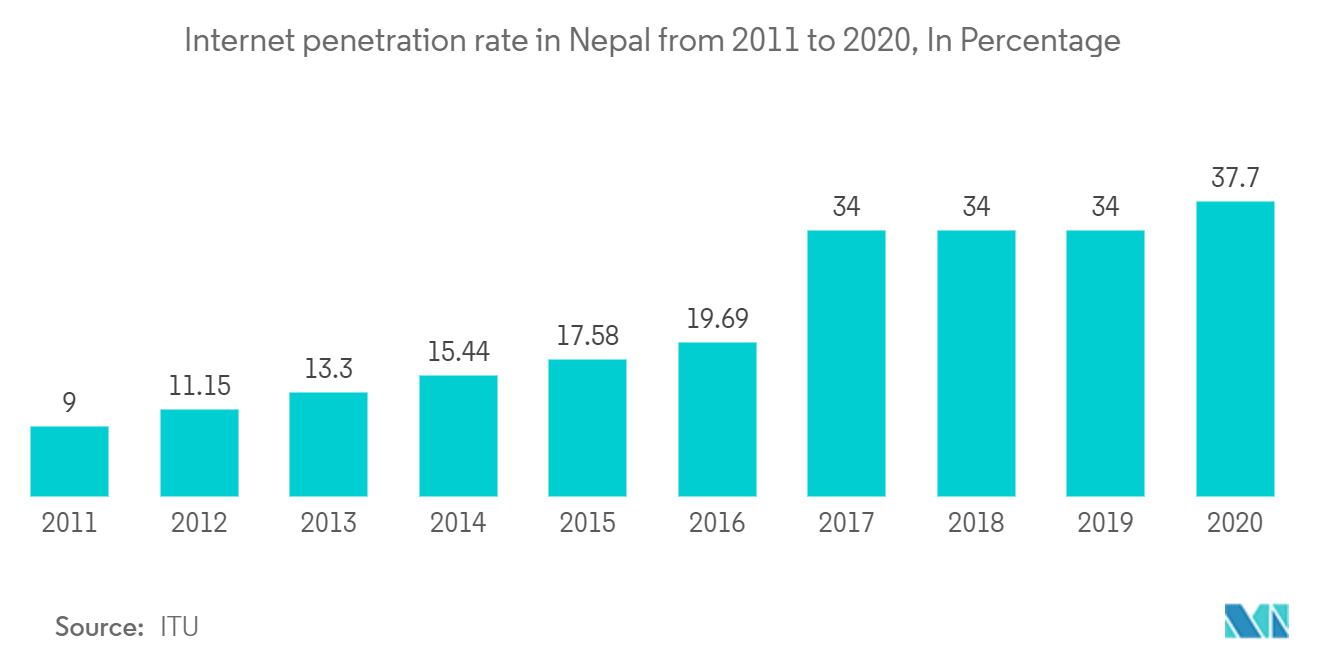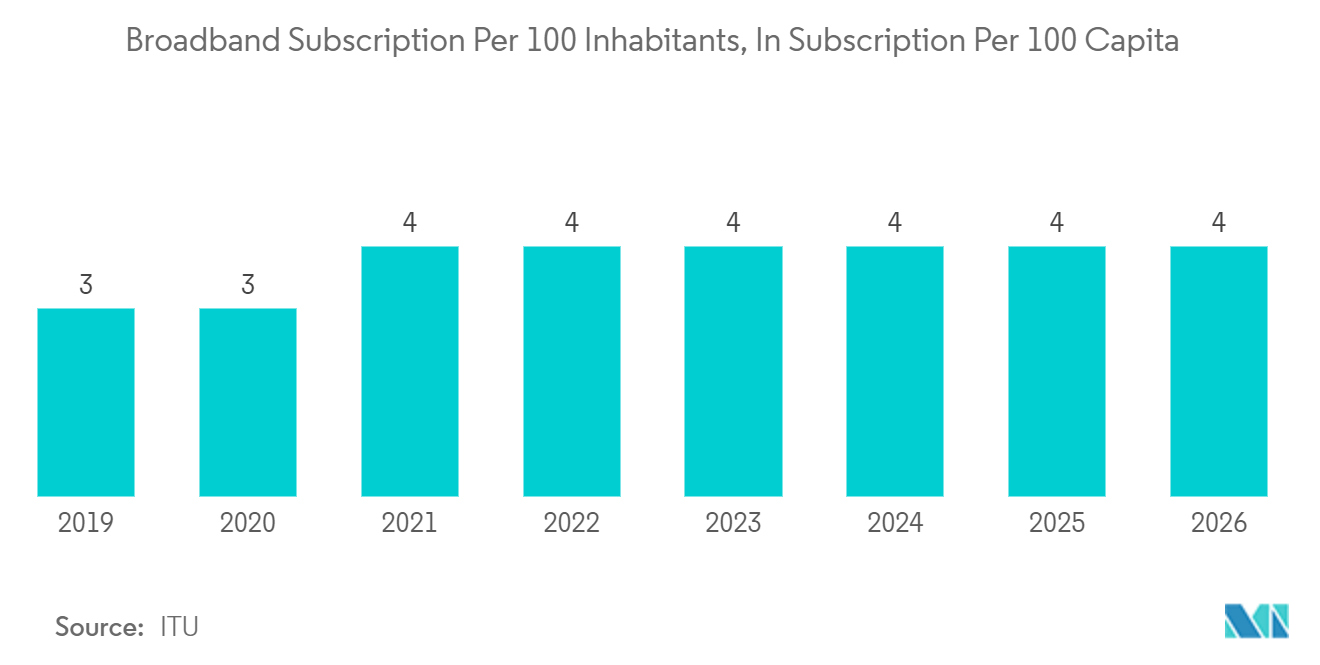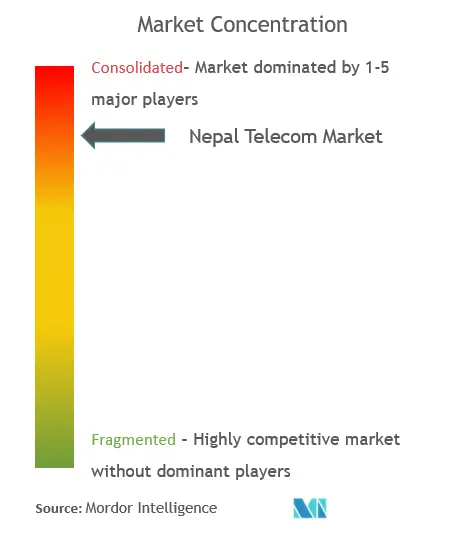Nepal Telecom Market Analysis
The Nepal Telecom Market is expected to register a CAGR of 7% during the forecast period.
- To make Nepal a significant center for international communications, the Nepali government has taken the initiative. In Nepal's telecom industry, the mobile market remains the key emphasis. Due to operator infrastructure expansion, Nepal's mobile sector continues to get most of the domestic capital investment. Government-sponsored reforms and policies, especially during the past decade, have fundamentally altered the landscape of Nepal's telecommunications industry.
- In Nepal, there is still room for growth in the fixed-line sector. The monopoly of the mobile market is a significant factor in this. As mobile usage for voice and data/broadband use continues to rise, the industry is expected to expand marginally more over the next five years through 2027. The overall wireless market in Nepal has grown incredibly quickly over the past five years and is now comparatively established. Due to fierce local rivalry and a relatively saturated market, the country would be restrained from seeing faster growth.
- The national telecommunications network in Nepal is massive. Robust growth in the number of telecom customers has forced network expansion to serve a larger region, necessitating a sizeable investment in telecom infrastructure. As a result of an increase in data use, the leading mobile providers are currently preparing to expand their coverage. High levels of investment have been made in new data centers due to the yearly growth in the amount of data processed and the rising need for data localization.
- With the extensive coverage of 654 local bodies and 85% of the population, Nepal Telecom expanded its 4G network to the nation's 77 districts. The fifth generation (5G) mobile internet, which would soon be available in Nepal, is supported by FTTH, making it a crucial initiative. Nepal Telecom (NTC) has long been involved in the 5G trend. In November 2021, the state-owned telecom obtained the 5G spectrum. And at long last, the business is about to start 5G trials in the nation after over a year of waiting. Sundhara and Babarmahal in Kathmandu would be the first locations where the telecom launches its fifth-generation network before moving on to more towns.,
- The COVID-19 outbreak brought attention to how crucial connectivity is to Nepal's society, commerce, and economy. Utilizing digitalization for the betterment of the nation's telecom expansion has been one of Government Nepal's main goals. It was the pandemic that accelerated this process. The government has also introduced technologies like Nepal National Single0 Window to make online import and export transactions more seamless. During the pandemic, mobile banking and mobile payment usage increased. As mentioned in an IIDS report on the Digitization of the Nepali Economy, digital transactions have increased dramatically from NPR 3.1 billion (USD 24000 million) in the fiscal year 2016-17 to NPR 221.1 billion (USD 1.70 billion in the fiscal year 2019-20. Undoubtedly, Nepal's telecom sector made massive progress during the COVID-19 pandemic.
Nepal Telecom Market Trends
Growing Internet Penetration in Nepal
- In many cities nowadays, having access to the internet is seen as a need across the country. Within the Kathmandu Valley, this is particularly true. Compared to rural regions, urban areas have higher internet penetration, device ownership, and accessibility. In Nepal, urban young make up the bulk of internet users, much like in industrialized nations. Some of the variables influencing this number include the accessibility, availability, and use of gadgets, the infrastructure that exists in most metropolitan areas, and the relative social and economic freedoms that urban youth enjoy.
- In the past year, there has been a sharp rise in the number of internet users in Nepal. It occurs because so many individuals now rely on the internet as a necessity in their daily lives. As most people in cities use the internet constantly, this is the typical sensation in Nepal right now. The statistical trend supports this as well. Nepal added 2.25 million new internet users in the previous year, according to TKP. The International Telecommunication Union (ITU) predicts that Nepal will lead the way in Internet penetration with a penetration rate of 79%, followed by China with a penetration rate of 75%. Similarly, it is anticipated that Nepal will dominate with a 124% mobile connection penetration in 2025, whereas India's mobile connection penetration will only be 98%.
- In January this year, there were 11.51 million internet users in Nepal. At the beginning of 2022, 38.4% of Nepal's population had internet access. Moreover, in Nepal, internet users climbed by 822 thousand (+7.7 percent) between last year and the current year, according to a Kepios study. For context, these user data show that 18.44 million people in Nepal did not access the internet at the beginning of the current year, which means 61.6% of the population was offline. According to Ookla's data, Nepal's median mobile internet connection speed has improved by 5.13 Mbps (+38.6 percent).
- According to the Economic Survey made by the finance minister, Nepal Doorsanchar Company Limited (NTC), the country's largest mobile network provider, has the greatest market share for internet service this fiscal year concerning subscribers, market penetration, and revenue numbers. NTC alone has a 48.9% share of all Internet subscribers, while Ncell makes up 32.8%. Additionally, 18.3% of the market comprises made up of various Internet Service Providers (ISP). According to the survey, mobile internet contributes most to the nation's internet penetration.
- Recently, Nepal Telecommunications Authority has proposed a rule that permits the consolidation of telecom service providers. Once the proposed legislation takes effect, both voice telephone operators and internet service operators may pursue mergers. Presently there are 138 internet service providers, which creates a congested market and makes it challenging for small-scale service providers. The businesses going for this merger would not only streamline their services but may also improve their capacity to adopt new technology, encourage service expansion, penetrate across unreached areas, and lower costs.
- According to ITU, internet connection was available to about 37.7% of Nepal's population last year. Compared to 2011, when only 9% of Nepal's population used the internet, this was a substantial gain.
Achieving Digital Transformation
- The Government of Nepal has a comprehensive vision for "Digital Nepal." The government's major initiative, Digital Nepal, is meant to make it easier for Nepal to link its rapidly growing socioeconomic population, which would aid in meeting the sustainable development objective of 2030. The vast unbanked population is the focus of Digital Nepal programs that promote the financial services industry by utilizing the telecom and digital infrastructure. Every year, more people own phones and mobile devices. The growth of information and communication inside the country has been effective for the government of Nepal.
- COVID-19 effects have been harsh, but one bright spot is the opportunity to fully use the digitization of telecommunication services' potential for improved lives. Due to the immense strain that telecom businesses and the government have been under from customers throughout the lockdown and the kind of momentum that digitalization has already gained, moving toward digital channels is the only choice left. The focus of all parties involved is now on enhancing the current digital infrastructure, including easy access to telecom and internet services, bringing service providers, such as companies and government organizations, on board the digital ecosystem in a sustainable manner, and raising customer awareness and engagement.
- Meanwhile, Ncell, the leading telecom company in the country, started and accelerated several significant digital efforts centered on, among other things, digitalizing its customer and channel interaction value chain so that consumers may interact virtually rather than in person, which has proven difficult during epidemic times. These were introduced early last year, and the company is still working to increase acceptance, usage, and monetization as the new way to connect with its customers. It would undoubtedly be necessary for customers to accept and become accustomed to this new way of engagement. Still, the company is confident that this is going to become the new nature.
- Furthermore, the government-backed Nepal Telecom has been permitted to sell and distribute M2M/IoT SIM cards with a new dedicated number range by the Nepal Telecommunications Authority (NTA), which had earlier ordered the telco to stop selling the SIMs last year. Nepal Telecom would once more provide SIM cards for device-to-device communication using the distinct number range of the National Numbering Plan. According to the publication, Nepal Telecom sold over 70,000 M2M SIM cards in the past.
- The Digital Nepal Framework initiative would receive NPR 22 billion (USD 170 million) in funding, according to the Nepali government. The money would be used to carry out some of the major digital initiatives. The ambitious and well-liked Digital Nepal Framework (DNF) lays out a strategy to increase digital literacy and foster the development of telecommunication in the country. There are several categories for this investment. One of them would get NPR 13 billion (USD 99 million) in funding for the deployment of the internet in rural regions. Additionally, the government would give ISPs financial incentives to deliver resilient high-speed internet service. A portion of the investment would also be used to provide internet access to low-income families, women, students, and people with disabilities. The government intends to provide community-based digital education for the inhabitants.
- As per the ITU report on Digital Economy Nepal, the Broadband subscription per hundred inhabitants in Nepal increased from 3 to 4 over the period from 2019 to last year, and it is expected to stay stable through 2026.
Nepal Telecom Industry Overview
The Nepali telecom market is moderately consolidated in nature. Some major players in the market studied include Smart Telecom Private Limited (STPL), Ncell Axiata Limited, Nepal Doorsanchar Company Limited (NDCL), CG Communications Limited, and WorldLink Communications. The market also hosts other Internet service providers (ISPs), MVNOs, and fixed-line service providers.
- In February 2022, new domestic interconnection fees were enforced by Nepal Telecom. The Telecommunication Authority of Nepal established the "Interconnection Fee" that customers of all telecom service providers must pay when calling or sending SMS messages to users of another telecom service provider's network. As soon as the New Domestic Interconnection fee is implemented, the tariff rates are changed, and the new domestic interconnection cost is put into effect.
- In September 2022, Ncell VoLTE, a Voice over Long-Term Evolution (VoLTE) service, was commercially offered by Ncell Axiata Limited with a few specific device models. VoLTE is a new technology that offers nearly instantaneous phone connection and improved quality high-definition voice communications. With the VoLTE service, phone calls may be made on the 4G network without switching to the 3G network, giving consumers access to both data service and high-quality speech at the standard voice rate.
Nepal Telecom Market Leaders
-
Smart Telecom Private Limited (STPL)
-
Ncell Axiata Limited
-
Nepal Doorsanchar Company Limited (NDCL)
-
CG Communications Limited
-
WorldLink Communications
- *Disclaimer: Major Players sorted in no particular order
Nepal Telecom Market News
- October 2022: Ncell introduced a new "Home and Away Data Pack." On Dashain, Tihar, and Chhath, Ncell Axiata Limited introduced this festive offer, allowing consumers to connect with loved ones, send holiday greetings, and experience excitement. Customers who purchase this deal receive a total of 60GB, a combination of 30GB of home data and 30GB of away data, for just Rs. 599, taxes included.
- November 2022: CGNET, one of the country's most esteemed and rapidly expanding Internet service providers, introduced the FTTH, super-fast internet service for a "Super Sasto Price." As a result, users can now take advantage of increased bandwidth at a competitive price in time for the World Cup, thanks to FTTH- Football to the Home. Customers can pick one of three packages with 1-, 3-, or 12-month validity periods.
Nepal Telecom Industry Segmentation
The report provides an in-depth analysis of the telecommunication industry in Nepal.
The market studied is segmented by service (voice services (wired, wireless), data and messaging services, and OTT and pay TV). The market sizes and forecasts are provided in terms of value (USD million) for all the above segments.
| Segmentation by Services (Coverage to include Average Revenue Per User for the overall Services segment, Market size and Estimates for each segment for the period of 2020-2027 and in-depth Trend Analysis) | Voice Services | Wired |
| Wireless | ||
| Data and Messaging Services (Coverage to include Internet & Handset Data packages, Package Discounts) | ||
| OTT and PayTV Services |
| Voice Services | Wired |
| Wireless | |
| Data and Messaging Services (Coverage to include Internet & Handset Data packages, Package Discounts) | |
| OTT and PayTV Services |
Nepal Telecom Market Research FAQs
What is the current Nepal Telecom Market size?
The Nepal Telecom Market is projected to register a CAGR of 7% during the forecast period (2025-2030)
Who are the key players in Nepal Telecom Market?
Smart Telecom Private Limited (STPL), Ncell Axiata Limited, Nepal Doorsanchar Company Limited (NDCL), CG Communications Limited and WorldLink Communications are the major companies operating in the Nepal Telecom Market.
What years does this Nepal Telecom Market cover?
The report covers the Nepal Telecom Market historical market size for years: 2019, 2020, 2021, 2022, 2023 and 2024. The report also forecasts the Nepal Telecom Market size for years: 2025, 2026, 2027, 2028, 2029 and 2030.
Our Best Selling Reports
Nepal Telecom Industry Report
Statistics for the 2025 Nepal Telecom market share, size and revenue growth rate, created by Mordor Intelligence™ Industry Reports. Nepal Telecom analysis includes a market forecast outlook for 2025 to 2030 and historical overview. Get a sample of this industry analysis as a free report PDF download.







